
Paleolithic Family Planning – From Mal´ta in Siberia to Iberia
*Corresponding Author(s):
Thomas E HeiseDepartment Of Social Psychiatry, Medical University Hannover, Germany
Email:thohei@gmx.de
Abstract
The idea behind the Paleolithic Venus statues found from Siberia till Iberia has been a riddle until today. Several Venus figurines by their incisions seem to give evidence Paleolithic Homo sapiens to have known about the fertile days to be hit for conception as early as 40.000 years ago. His Neanderthal cousin wasn´t able to do so, due to a poorer sense of smell and reduced cognitive flexibility. His disadvantage may have helped our ancestors to survive. Still in the 19th century similar wooden figurines, but made of wood, could be found in Siberia. However, the meaning of it seems to have been distorted a little at the end of such a long period of tradition. A “contextological” approach also suggests that scarifications as seen in traditional African tribes may have been existing since long ago and serve the same purpose. A mammoth tusk plate with spirals incised found in Mal´ta (Siberia) about 80 years ago may have been used to memorize and calculate the stage of pregnancy. This can be considered as a second and more sophisticated onset of preventive medical thinking and gynecology about 20.000 years ago. Nowadays in the situation of an overpopulation we apparently must spread this knowledge again, to prevent hunger, war and natural or manmade disaster maybe leading to an over control and loosing liberty.
Keywords
Fertility planning; Mal´ta; Neanderthal extinction; Paleolithic Globalization; Preventive medicine; Venus’s statues
Introduction
Emphasizing a kind of “contextological” thinking as a kind of “software” to identify the gaps between the different faculties and subjects of study can help to bridge them from different sides like medicine, prehistory, ethnology, anthropology, and paleontology to find solutions for problems with as little prejudice as possible [1]. The “hardware” consists of the earliest human representations known by now, figuring the female plastics, called Venuses or female horizon statues and related archeological findings.
Paleolithic female statues have been excavated for more than a century and have been investigated in various ways. Some facts are easy to get access to. Their size varies from 2 to 20 centimeters about. The material used is rock like limestone, serpentine, black jet, or animal derived material like mammoth ivory, antler, bone, or even artificially processed ceramic objects. Disregarding the very few oldest ones made of stone, there is no real chronological follow-up between the three groups.
These female figurines, whose time of origin is hardly disputed any more, date from the ivory Venus of Hohle Fels [2], found in the Swabian Alb region, Germany, which is by now the eldest one with about 40,000 years BP; the ceramic Venus of Dolní Vestonice, found in Moravia, Czech Republic, and dating from between 31,000 to 27,000 BP; the limestone Venus of Willendorf , Lower Austria, dating from between 26,000 to 24,000 BP; the ivory Venuses of Mal´ta and Buret at a distance of 15 kilometers away from each other, Irkutsk Oblast, Russia, dating from about 23,000 BP; and – last but not least - the ivory Venus of Brassempouy from Aquitaine, France, dating from 22,000 BP. These are well-known ones, mostly connected with the Gravettian and Solutrean epoch. The representations show a variety of female body parts, sometimes only the head, or the body with a smaller head, neglecting details and emphasizing breasts, vulva, abdomen, hips and thighs there. Clear signs of pregnancy are rare.
The meaning of those female statues has been subject to a lot of speculation from pornographic imagery to emblems of security, re-presentation of the mother or just local goddess to fertility icons. Their waist-to-hip ratio seems to provide regional differences as women and even paleocultures are different, not leading to further conclusions [3]. Recent exhibitions don´t provide any more help [4]. Analogue: Formerly phallus symbols as cultic objects have now been recognized to have been the first matches [1]. According to the prevailing opinion, the incised lines may symbolize skin clothing [5]. Regarding some facts, we see the Venus of Willendorf to show a lot of curly hair. Another roughly done figurine named “A so-called bouchon à outre in ivory, discovered during the AFAS excursion to Brassempouy on September 19, 1892” (White 2006) shows a lot of detailed cuttings like tiny curls on something which could be considered as a head. Three Venuses of Mal´ta and the one of Hohe Fels have a lot of lines incised on their body. The abdomen of Venus of Polichinelle (coll. MAN) and the head of the Flattened Figure (coll. Bolduc) show fine incisions. The Venus of Zaraysk shows a lot of lines on the head. Some Venuses, like the ones from Mal´ta, Hohe Fels, the Flattened Figure from Grimbaldi and others have a small loop either in the neck or between the feet making it possible to wear them round the neck. The Venus of Laussel has 13 incisions on the horn she is leading to her mouth and with her left hand showing to the womb.
The age of the more than 200 Venuses discovered in Europe and Asia ranges between about 40.000 to 10.000 years old.
Salomon Reinach was the first to state in 1903 “Palaeolithic art” to have a utilitarian and not an aesthetic background [6]. He even cited Hirn [7] saying: ‘this art is seldom free and disinterested; it has generally a usefulness real or supposed and is often even a necessity of life’. Besides, he is known for seeing a close link between the birth of art and religion [8]. This holy necessity of art for life may be emphasized. Only recently Missonova [9] repeated, the sacred knowledge was transmitted over generations by visual art. White [10] writes “paleolithic images of women are among the most fertile sources of debate in all of archaeology. At the same time, they remain one of the most poorly known.” Except for Rosenberg´s work on timely much earlier problems, little work has been done so far on female-specific issues [11]. The aim of this work was to bring an interdisciplinary light into the discussion about the Venus statues, hopefully giving it a new turn.
The paleolithic site of Mal´ta, Siberia, was excavated by Gerasimov [12] from 1928 to 1930. In Mal´ta, it was recognized the wo-men´s sitting ground was opposite to the one for men around the hearth place [13]. It didn´t only show Venus’s figurines there, but also animals and a small mammoth tusk plate with snakes chiseled in wave-shape in it on one side and chiseled dots on the other side. Delporte [14] measures 136 mm by 82mm without explanation. Hitchcock, relating to Gerasimov, refers to its attribution to the Maltinsko-buretskaya Culture, dating 23,000 – 19,000 BP. He describes as few as two interpretations for one side only: the three snakes he sees could be Cobras, now only known in southern Asia, or second, they could be illustrations of rivers proceeding from glacial lakes. By interpreting the lines incised in a bone, Marshack [15] was the first one to claim people in the Upper Paleolithic of Europe to have been marking time and to have understood the lunar year. Two recent articles about the symbolic objects from Siberian Yana RHS do not mention the Mal´ta findings [16,17]. Hopefully this article now can point out the importance of this paleolithic site, especially regarding the early comprehension of women in general and of reproduction in particular.
Findings
Anati [18] was the first and to my knowledge only one to suggest shortly one of the Venuses of Mal´ta possibly to be related to the female monthly cycle. The first six carvings are on the head, and number 14 to 16 are in the genital area of the lady (one line is a bad cut and only represented on the left body side), and then it goes down until 24, where the loophole is. Anati did not compare this single finding with others or look for any support of this first idea, even when there was a second similar figure found in Mal´ta but in worse condition (Figures 1 & 3A).
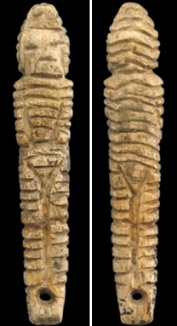 Figure 1: a/b Venus of Mal´ta. Source retrieved 31.01.2023: https://www.donsmaps.com/malta.html.
Figure 1: a/b Venus of Mal´ta. Source retrieved 31.01.2023: https://www.donsmaps.com/malta.html.
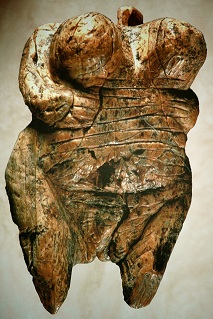 Figure 2: Venus of Hohle Fels. Photo: Ramessos. https://de.wikipedia.org/wiki/Venus_vom_Hohlefels#/media/Datei:VenusHohlefels2.jpg
Figure 2: Venus of Hohle Fels. Photo: Ramessos. https://de.wikipedia.org/wiki/Venus_vom_Hohlefels#/media/Datei:VenusHohlefels2.jpg
The Venus from the Hohle Fels [19] (Figure 2) has incisions around the elbow and from the upper arm to the shoulder, as well, all of them looking composed, done in two pieces and more looking like a clan symbol / tattoo than a part of the overall counting. It rather begins with three vertical incisions on the outside of each breast with the fourth starting there and then build a horizontal line under the breasts – which look as if they were full of milk and are pressed a little up and forward by the hands under them - and other lines lower on the body reaching the upper genital area with number 14. While the middle genital part is not touched by the lines, they continue more downward till line 21 where some body parts are in poor condition or even lacking. Besides a lot of animals discovered from that time at the same place have patterns or some incisions, showing that counting and giving it a meaning - we must decipher - was no problem. And further still for rounding up the subject of fertility from about 28.600 BP a phallus was unearthed there.
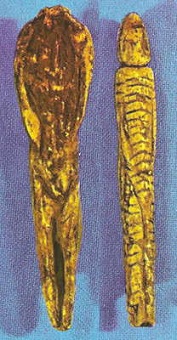 Figure 3A: Venus of Mal´ta – Gerasimov. Source retrieved 31.01.2023: https://www.donsmaps.com/malta.html
Figure 3A: Venus of Mal´ta – Gerasimov. Source retrieved 31.01.2023: https://www.donsmaps.com/malta.html
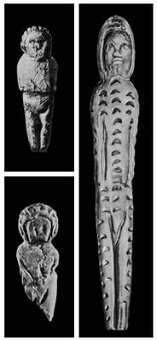 Figure 3B: Venus of Buret. Source retrieved 31.01.2023: https://www.donsmaps.com/malta.html
Figure 3B: Venus of Buret. Source retrieved 31.01.2023: https://www.donsmaps.com/malta.html
One Mal´ta figure [20] discovered by Gerasimov [12] near Irkutsk shows 3 lines on the arm and 26 lines on the back from the neck to the feet, while the front side is hard to recognize. A second one – mentioned by Delporte [14] as well - which is marked very clearly and easy to count on the backside with 6 menstruation days on the head, is the one described by Anati, as mentioned above. Additionally, it must be said that the same incisions on the Buret Venus statue bear a clear lunula form, again reminding us of the importance of the moon for the female sexual life (Figure 3B). The Venus of Laussel, 27.000 - 22.000 years BP, holds a lunula formed bison´s horn with 13 or 14 incisions in her right hand, may be to remind, when it/she has to be filled by him (Figure 4).
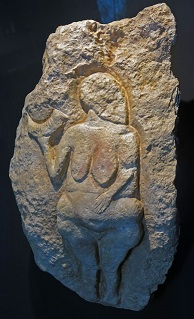 Figure 4: Venus of Laussel. Photo: https://www.donsmaps.com/images33/img_6531lausselcorne.jpg
Figure 4: Venus of Laussel. Photo: https://www.donsmaps.com/images33/img_6531lausselcorne.jpg
And even, there is a Priapus from Laussel, dating about 22.000 BP, as a kind of counterpart for her aim. In the Magdalenian cave La Madeleine, Vézère Valley / Dordogne, we find on one side the extremely naturalistic reclining Venus sculptured on the cavewall, on the other side two carved phallus from the antler and additionally some carvings on a bone showing a snake, with ten small thornlike incisions at the tail, which is finding its way through arrays of 25 incisions connected to 18 V-like carvings. But the snake is going in direction to a man and a horse, which make it look more like a male object which needs further investigative ideas.
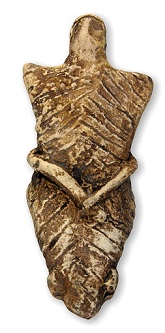 Figure 5: Venus of Cucuteni. Source retrieved 31.01.2023: http://www.topgeo.de/venus_von_cucuteni_abguss__2439.html
Figure 5: Venus of Cucuteni. Source retrieved 31.01.2023: http://www.topgeo.de/venus_von_cucuteni_abguss__2439.html
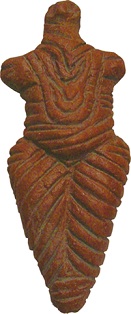 Figure 6: Venus of Romania. source retrieved 01.01.2013: http://upload.wikipedia.org/wikipedia/commons/7/70/Venus_Roumanie.png
Figure 6: Venus of Romania. source retrieved 01.01.2013: http://upload.wikipedia.org/wikipedia/commons/7/70/Venus_Roumanie.png
Also, in the neolithic times this idea can still be found. The Venus of Cucuteni shows 14 stripes from the shoulders to reach the genital triangle on where she is folding her hands. The Venus of Romania, Cucuteni Culture 7000 BP, shows five menstruation days as sort of necklace engravings and then reaches the vulva with number 14 (Figures 5 & 6).
The female menstruation is 3 to 6 days, causes headache to some women. Many of them can feel the fertile days (usually from day 13 to day 15 of the female cycle); the lifespan of the male sperms (usually 3 days, maximum 4 days) must be counted before the fertile days, so the couple knows when conception is possible. Nowadays, the whole cycle is about 28 days in most of the women with a wider variation especially after ovulation. But this important time period from day 13 to 15 is in most of the Venuses, who have lines, hitting the genital area.
Counting up and down, both movements of the curls of Venus of Willendorf (Figure 7) the number seems to be close to 266; this equals the time of pregnancy indicated on the Mal´ta mammoth tusk plate [21]. Other Venus´ curls are half erased or vaguely incised (bouchon à outre in ivory, from Brassempouy) and even more difficultly to count. Still other Venuses like Kostenki I have a considerably higher number of curls or knots, indicating that not everybody got the idea of it.
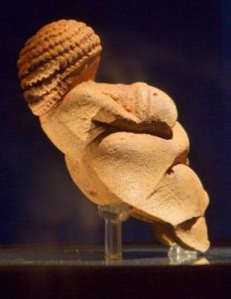 Figure 7: Venus of Willendorf, Vienna Natural History Museum, Photo Don Hitchcock.
Figure 7: Venus of Willendorf, Vienna Natural History Museum, Photo Don Hitchcock.
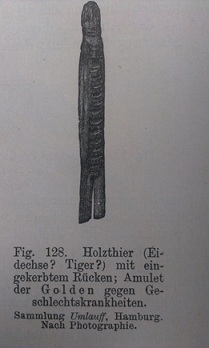 Figure 8: Venus of Golden 1.
Figure 8: Venus of Golden 1.
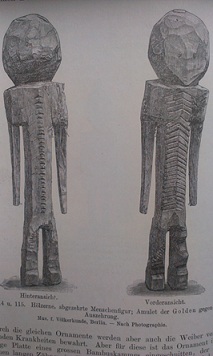 Figure 9: a/b Venus of Golden 2.
Figure 9: a/b Venus of Golden 2.
Another means of transmitting the knowledge of fertility maybe scarification, and perhaps the figurines just represent them. For the comprehension of this kind of media, it is helpful to use a transcultural [22] and transtemporal way [23] in the contextological approach. The Golden or Nanai tribe at the Amur River in Siberia has wooden figurines, supposedly from the 19th century, that look very similar to the paleolithic objects (Figures 8 & 9). One shows fourteen incisions from the neck to the genital triangle and this figurine used to be interpreted as a “wooden animal” (looking at the incised lines like the comb at the lizard´s back) which is supposed to be useful “against genital diseases” [24]. So, a part of the context was still regarded correctly after tens of thousands of years. Another very slim figurine shows four incisions in the upper part, which are separated from the next ones, going down to the genital triangle with number 25, while on the back 27 incisions can be counted. According to earlier interpretations the figurine shows a person suffering from tuberculosis [24]. Many severe diseases can be accompanied by irregular menstruations, and women affected are not supposed to have a child anymore. Maybe, therefore the ovulation day is not marked – or the whole meaning was distorted and forgotten. If there might be any connection between the incisions and the flittered clothing, which is still known in some Siberian people [25], it is supposed to be secondary, or may be is meant to be another expression of the knowledge about fertility. But as an original meaning often gets lost during the centuries, it is sometimes changed until it can no longer be recognized easily or not anymore at all. Sometimes even two things get mixed by their similar appearance which don´t have to do anything with each other.
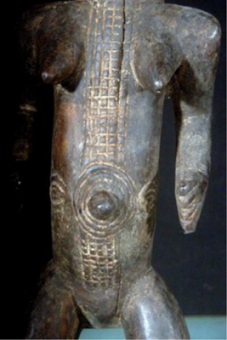 Figure 10: Venus of Massa people in Liberia. Author´s coll.
Figure 10: Venus of Massa people in Liberia. Author´s coll.
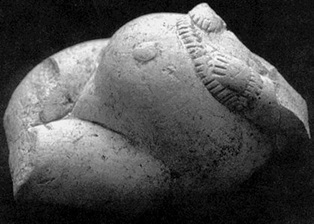 Figure 11: Venus of Kostienki, limestone. Photo: P. Bahn, 'Prehistoric Art'.
Figure 11: Venus of Kostienki, limestone. Photo: P. Bahn, 'Prehistoric Art'.
The Massa people in Liberia made a wooden figurine (Figure 10) about during the first half of the 20th century – and there are more of them, some of which come from other people like the Igbo in Congo, where the scars were counted beginning from the woman´s genital area and reach the umbilicus with number 14, while numbers 11 to 14 form circles around the umbilicus; this was for the woman not to forget those important days which make the navel come forward a little – like the torso of the Kostienki limestone Venus as well, representing another sign of pregnancy. This Venus has her necklace with all the beats for the monthly cycle stretched on her pregnant belly and fixed to the bracelets at the arms, may be to show that the monthly cycle wasn´t valid any longer (Figure 11). - The African upward counting to the neck is somewhat longer, but for planning the time of fertility, it is not of great importance as this is the timespan which may vary more between women.
Another finding concerning Mal´ta is the mammoth tusk plate with the snakes’ side and the dotted points on the other side, which has been published before [21].
Delporte reported [14] regarding the 1950ies excavations in Mal´ta that there were more than a dozen representations of stylized birds found in the 'male habitat' areas, to the right of the fire-places. They were carved in mammoth ivory in a remarkably homogeneous way, regarding their form and style. The rather rhomboid head pointed upward and reminiscent, both in its form and how it connects to the neck, of the head of a snake. The body always has a perforation at its base, so that it could be worn around the neck.
It must be mentioned, that besides the likeness of these objects with animals like flying birds and snakes there is also a resemblance to the male erect penis and scrotum, making the person´s body just an ovoid basis at the end that still resembles the snake head and serves for piercing with a loop. And as these objects have all been found at the right side which was the male “habitat”, so in this context it makes sense to suppose it is the sexual equivalence to Venus’s statues and both meet on the prenatal recording schedule, after the first step of the work of fertility is done. So, we obtain new insights into the early human behavior [26] and its evolution process (Figure 12).
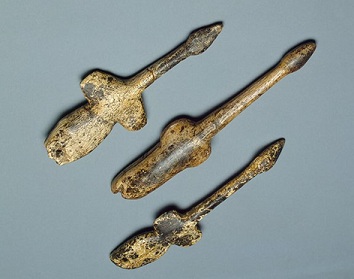 Figure 12: Flying geese & male sexual organ, (photo Hermitage Museum)
Figure 12: Flying geese & male sexual organ, (photo Hermitage Museum)
The two snakes with two broad heads represented on the other side of the before published mammoth tusk plate may thus not only be the clan symbol but represent the smaller one as the female and the other one as the male, the yin and the yang, who meet to fulfill mother earth´s and nature´s law of fertility, a holy action combining the creation of the generations with the survival of the clan in a nature, looking for survival in the cosmos. Connected to the tail on the left side, the big snake shows 10 windings probably representing the 10 lunar months of pregnancy. Besides, Okladnikow reminds us not only of the probably early use of tattoos as pictured in petroglyphs (23: 116), but also that for the shamans of the Siberian tribes the snake [25] was a holy animal and a helping spirit as well. He also describes snakes with broad heads on prehistoric rock carvings and pictures at the Kamennyje Ostrowy stone islands near the village of Jegorowa [27]. This village is at about 60 kilometers by boat from Mal´ta, on the Angara River.
Discussion
A morphological comparison of a newborn Neanderthal baby´s skull with an adult one using brain endocasts could yield evidence regarding the development of these to be different enough from Homo sapiens to explain different cognitive abilities [28-31]. Some missing Neanderthal genes could contribute to that [32]. Also, another brain nerve, the sense of smelling, seems to be developed better in Homo sapiens [33]. The typical Neanderthal Levallois flint stones found in the middle of Germany, and the technically more advanced Homo sapiens flint stones found close to the other ones show the Neanderthal man to be apparently unable to use and apply this existing technological knowledge himself, probably because of lacking mental capabilities and flexibility [34]. On the other hand, he demonstrated his cognitive capacity for long-term working memory by using a deliberate, engineered strategy to form the Levallois flints to reach a specific goal [35]. Besides, there have been some strong points like 93.1 percent of Neanderthal people were right-handed, which predicts them the ability to speak, because of the left-brain laterality [36]. They possessed a probably necessary gene [37] and the anatomical structure for this (os hyoideum) [38]. Viewing the Homo erectus to have already cruised the Mediterranean [39] and Indonesian islands [40] long before, it has been suggested that constructing and handling rafts, and most probably passing down the knowledge, is not possible without verbal communication. So why shouldn´t his descendants like the Neanderthal and the Denisovan hominin [41] be able to do the same. Even a group of 13 Neanderthals discovered in El Sidrón Cave in northern Spain, about 50,000 years old, were able to choose their food according to specific needs like taking the bitter medical herbs yarrow and chamomile against inflammation [42]. He had his own evolutional process, which probably included before the arrival of Homo sapiens the first cave art [43], wearing feathers and bird claws [44,45], using charcoal [46] to warm from the outside and lissoirs for processing furs to better keep the body warmth inside [47]. He produced necklaces [48-50], some of which he may have seen when meeting Homo sapiens. His social abilities are well-known, caring for old and handicapped persons [51]. Graves of 49,000 to 32,000 years BP in Shanidar / Iraq also give evidence of the use of medical herbs, and obviously of burial rituals, including the use of a ram horn. But if the digit ratios are indeed an expression of the hormonal status and can be used to predict polygyny [52], it may not have been sufficient to court only one woman. So, he had no peace in his mind to think of one single fixed partnership more deeply. This means the Neanderthal man probably would not count and plan about all possible women´s monthly cycle in the same way as the Homo sapiens could do, even if he would have had the mental capacity to do so.
So the knowledge about family planning regarding his fixed partnership gave Homo sapiens an edge compared to his Neanderthal cousin, who anyhow seems to have had a still lower reproductive rate.
But how did we get this knowledge? It has been shown that at the time of ovulation the smell of the vagina is more neutral and less sour than otherwise, as the luteinizing hormone is increasing to make the sperm survive for a longer period. It is known that the Neanderthal cousin had a bigger nose with an olfactory mucosa more in front than Homo sapiens [53]. Still, we outwitted him, as we had developed a 12 percent bigger representation of the temporal lobe and the olfactory lobe of the brain [33]. And this part of the brain is also in correlation with the perception of feelings.
A tenfold population increase [54] in modern Homo sapiens at that time is more comprehensible when we realize he had this medical knowledge, which he could increase by the time. This can be shown by the mammoth tusk plate´s incisions, found in Mal´ta as well, 23.000 – 19.000 BP.
The question what came first was raised several times. According to archeological and genetic research we find new microlithic tools and other new techniques of tool making [55,56] as well as the use of first hygienic measures [57] around 73,000 – 72,000 years ago. There is evidence for a first wave of increasing Homo sapiens population in South Africa from 60,000 to 58,000 according to genetic [58] and archeological [57] research. The region getting too crowded was, may be, one reason for the emigration of Homo sapiens. At the transition from Neanderthal to Homo sapiens around 35,000 years ago we find a tenfold increase of population in Western Europe [54] as well as in South Asia [59] 35,000 – 28,000 years ago, as new microlithic tools have been invented there about that time. Then we got the finding of ceramics unequivocally used for cooking 20,000 years ago [60] in Central China, 17,000 years ago [61,62] in North and South China, and 12,000 years ago in pre-Jomon Japan. In three Chinese genetically examined populations evidence was found for a thirtyfold population increase about 13,000 to 4,000 years ago and for a population increase in Japan, 14,000 years ago, especially between 8,000 – 5,000 years ago [63]. In the findings of North China close to the Mongolian border the earliest Neolithic culture by now is Baiyinchanghan I, dating back to about 8,200 cal. years BP, close to Jinan at the Yellow River at Houli, dating back to 9,000 to 8,500 cal. BP, measuring as much as 40,000 to 100,000 m² for this settlement with square houses of 30 to 50 m², showing mostly two or three hearths and a fine ceramic [64]. The general idea is that for all those areas the real contribution of plant husbandry started later.
It looks as if things had developed step by step but not everywhere to the same degree and extent. It was a big advantage for the people to calculate not only the female cycle, as they evidently had done for 40,000 years at least, but also to know now about the different stages of pregnancy and when to expect and prepare for the baby. As a result, more siblings could survive. To help feeding the now rising population, existing tools and means had to be more sophisticated, and their use had to be extended. The trade with tools and ideas increased probably as well. Later plant husbandry had to be added and the useful land to be prepared and guarded. It seems that the relationship between man and woman started to change [65,66] at that time gradually everywhere according to other cultural changes. So, it looks as if mankind first needs the dilemma and then, to help him out of this challenge, the knowledge about the latest developments is deepened, and new means are found.
Nowadays we are at a threshold. Once homo sapiens used his knowledge about fertility and birth control to populate this planet. Having not enough population is a threat to extinction, as can be seen by our cousin from Neanderthal. Even when he made something so miraculous like the stalagmite constructions in Bruniquel cave (Southwest France) [67] about 176,500 years ago, he vanished from earth, leaving only genetic traces in modern man [23]. These astounding recent findings like others [68] remind us, how little we know about history. But also, the contrary side of overpopulation is threatening. We are about to experience this now. So, we should again use our knowledge about birth control to limit the number of offspring to one or two. Along with this we must find back to a more healthy, resilient and nature oriented paleolithic thinking. This means we must change our still neolithic behavior. It is characterized by exploiting without comprehension and real understanding the whole nature including ourselves. We need a humanistic, empathetic, and resilient lifestyle instead of being governed by narcissistic and aggressive monarchs, oligarchs, dictators, merchants, and bankers, who try to control with a destructive globalization the world leading to mechanistic, transhumanistic desired self-illusion, resulting in an unhuman world. A harmonious way however can be achieved by an overall education as well for birth control for everybody and an holistic [75], healthy lifestyle filled with mutual help and love instead of a destructive win-loose situation.
Conclusion
A clan who 40,000 years ago had the knowledge that allowed it to plan its offspring for both the number and the time of birth had a big advantage – even against his Neanderthal cousin, who was less flexible. It could choose the most appropriate season for the easy survival of the baby and control the number of babies according to the existing food reserves and to the current number of members. The defense of the clan should not be put at risk by too many children who would have made the group inflexible and vulnerable. Let´s learn from them!
Jean Clottes and colleagues claim that there may be some cultural connection between the cave painters in France (Chauvet) and those in Romania (cave of Coliboaia 35,000 – 23,000 BC) [69], as similar stylistic elements convince him to propose this [70]. An even much more far connection, like from Siberia to Iberia, was already mentioned for much earlier times [71].
For the Greek Franchthi Cave [72] was found out that it was occupied sporadically before and shortly after the CI ash fall (35 ka BP or 40–39 ka cal BP). Aurignacian-like assemblages were also found at the Kostenki-Borschevo sites in Russia, embedded in the CI [73] and sites of similar dates could be specified in Isturitz in the southwest of France and a maybe pre-Early Aurignacian context in Geissen-kloesterle, Germany, and Willendorf, Austria, along the Danube fluvial corridor. No disruption of cultural transmission can be found then.
So, this Eurasian link over times and spaces (up to recent customs in Africa), another kind of globalization, was maybe even broader and more intense as long as 40,000 years ago, than we would have thought ever before, and it includes preventive medical aspects, thus giving us more insight into early human behavior [26]. And as early as 22,000 years ago people could evidently calculate the time of birth so exactly as more or less, we do today. So, they obviously had an insight into many things we haven´t suspected until now. It seems possible they could have been able to calculate the stars by then as well [74], to determine the changing of the seasons and when to follow the animals best for hunting etc. It has been suggested that people in South Africa used the moon calendar [55,56] much earlier; this would match with these new findings about preventive medicine. And when paleolithic people thus used their knowledge on fertility and birth control, how come we neglect it and cannot even take the next step and leave the modernized neolithic times of today into a better holistic and resilient epoque?
Acknowledgement
The author acknowledges the many very valuable discussions with Prof. (ung.) Stephan Palos, and the work of Don Hitchcock, who makes archeological data known on his website. Thankful to The Hermitage Museum, Saint Petersburg, for giving permission of publication of their photos.
Statements and “Compliance with Ethical Standards”
- The author followed the rules of good scientific practice, which include:
- The manuscript has not been submitted to more than one journal for simultaneous consideration.
- The manuscript has not been published previously (partly or in full), unless the new work concerns an expansion of previous work (please provide transparency on the re-use of material to avoid the hint of text-recycling (“self-plagiarism”)).
- A single study is not split up into several parts to increase the quantity of submissions and submitted to various journals or to one journal over time (e.g., “salami-publishing”).
- No data have been fabricated or manipulated (including images) to support your conclusions
No data, text, or theories by others are presented as if they were the author’s own (“plagiarism”). Proper acknowledgements to other works must be given (this includes material that is closely copied (near verbatim), summarized and/or paraphrased), quotation marks are used for verbatim copying of material, and permissions are secured for material that is copyrighted.
Conflict of Interest
The author declares that he has no conflict of interest.
Overview Box
What do we already know about the subject?: About 200 paleolithic Venus´s figurines discovered in Europe and Asia are between ca. 40.000 to 10.000 years old. Their purpose remained unclear.
What does this theory add to our knowledge and what are the highlight benefits? > By putting knowledge from different fields like anthropology and ethnology together, and investigating all the archeology related material with a medical eye, > a paleolithic description of the female cycle shown on Venus´s figurines is proposed for the time as early as 40,000 years ago. > Homo sapiens had a better olfactory sense than Neanderthal man. Thus he may have detected the changing smell of the vagina at the time of ovulation. > This could lead to first the planing of conception and second let birth take place in favorable seasons, making him multiply faster than his cousin. > Added to this was the proposed ability to follow even the whole pregnancy about 23.000 to 19.000 years ago, like a mammoth tusk plate incised calendar and the number of curls on the heads of some Venuses suggest.
What further study is proposed to test the idea?: There is the possibility, that to memorize the day of the female cycle, the incision was painted one per day with some ocher or hematite stone color. To test this early preventive medical thinking it is proposed, to examine the incisions of the Venus´s statues as well as the curls of the hair and the incisions in the mammoth tusk plate. If by infrared and microscopic examination some traits of colors (red as the color of life) could be found, this theory would be even more plausible than now. And medical anthropology could investigate, if the scarifications on wooden statues in Siberia and Africa are still known to be related to women´s fertility. So could do ethnology with the scarifications performed similarly on the bodys of young women in Africa.
References
- Goren-Inbar N, Freikman M, Garfinkel Y, Goring-Morris A.N, Grosman L (2012) The Earliest Matches. PLoS ONE 7: 42213.
- Conard NJ (2009) A female figurine from the basal Aurignacian of HohleFels Cave in southwestern Germany. Nature 459: 248-252.
- Tripp A, Schmidt NE (2013) Analyzing Fertility and Attraction in the Paleolithic: The Venus Figurines. Archaeology Ethnology & Anthropology of Eurasia 41: 54-60.
- James N (2012) Cherchez la femme—a Palaeolithic preoccupation. Antiquity 86: 558-560.
- Mellars P (2009) Origins of the female image. Nature 459: 176-177.
- Hansen MK (2006) Beyond Seals (Pg No: 29). University of Tromsø, Norway.
- Hirn Y (1990) The origins of art: a psychological and sociological inquiry. Macmillan, London, UK.
- Palacio-Pérez E (2010) Salomon Reinach and the religious interpretation of Palaeolithic art. Antiquity 84: 853-863.
- Missonova LI (2013) Sacred space in the worldview and art of the Tungus-Manchu ethnic minority, Sakhalin Island. Archaeology Ethnology & Anthropology of Eurasia 41: 121-130.
- White R (2006) The Women of Brassempouy: A Century of Research and Interpretation. J Archaeol Method Theory 13: 250-303.
- Rosenberg K, Trevathan W (1995) Bipedalism and human birth: The obstetrical dilemma revisited. Evol Anthropol 4: 161-168.
- Gerasimov MM (1964) The Paleolithic site of Mal’ta: excavations of 1956-1958. Michael EN (edn) The Archaeology and Geomorphology of Northern Asia. No. 5, S. 3-32, Arctic Institute of North America, University of Toronto, Canada.
- Hitchcock D (1999) The Mal'ta - Buret' Venuses and culture in Siberia.
- Delporte HL (1979/1993) Image de la femme dansl’artpréhistorique. Picard, Paris, France.
- Marshack A (1988) La penséesymboliqueetl´art. Dossiers d'Archéologie 124: 80-90.
- Pitulko VV, Nikolsky PA, Girya EY, Basilyan AE, Tumskoy VE, et al. (2004) The Yana RHS Site: Humans in the Arctic Before the Last Glacial Maximum. Science 303: 52-56.
- Pitulko VV, Nikolskiy PA (2012) The extinction of the woolly mammoth and the archeological record in Northeastern Asia. World Archaeology 44: 21-42.
- Anati E (2002) Höhlenmalerei. Patmos, Düsseldorf.
- Conard NJ (2004) Palaeolithic ivory sculptures from southwestern Germany and the origins of figurative art. Nature 426: 830-832.
- Jelinek (1972) Mal´ta Venus’s photo.
- Heise TE (2022) Paleolithic Preventive Medicine: The Prenatal Recording Schedule of Mal´ta. J Altern Complement Integr Med 8: 306.
- Heise TE (2022) Transcultural Psychotherapy. In: Hersen M, Sledge WH (ed.). Encyclopedia of Psychotherapy. Academic Press, Elsevier Science. USA.
- Heise T (2016) Kulturen der Menschheit: Woher und wohin? Transdisziplinäre Perspektiven unserer Vergangenheit. Königshausen & Neumann, Würzburg, Germany.
- Bartels M (1893) Die Medicin der Naturvölker. Ethnologische Beiträge zur Urgeschichte der Medicin. Grieben´s Verlag, Leipzig, Germany.
- Okladnikov AP (1974) Der Mensch kam aus Sibirien. Molden, Germany.
- Petraglia MD, Korisettar R (1998) Early Human Behaviour in the Global Context: The Rise and Diversity of the Lower Palaeolithic Record. Vorge-schichtliche, Routledge, USA.
- Okladnikov AP (1972) Der Hirsch mit dem goldenen Geweih. Vorgeschichtliche Felsbilder Sibiriens. Brockhaus, Wiesbaden,
- Gunz P, Neubauer S, Maureille B, Hublin JJ (2010) Brain development after birth differs between Neandertals and modern humans. Current Bio-logy 21: 921-922.
- Maureille B (2002) La redécouverte du nouveau-né néandertalien Le Moustier 2. Paléo 14: 221-238.
- Maureille B (2002) A lost Neanderthal neonate found. Nature 419: 33-34.
- Neubauer S, Gunz P, Hublin JJ (2010) Endocranial shape changes during growth in chimpanzees and humans: a morphometric analysis of unique and shared aspects. J Hum Evol 59: 555-566.
- Green RE, Krause J, Briggs AW, Maricic T, Stenzel U, et al. (2010) A draft sequence of the Neanderthal genome. Science 328: 5979.
- Bastir M, Rosas A, Gunz P, Melian PP, Manzi G. et al. (2011) Evolution of the base of the brain in highly ncephalized human species. Nature Communications 2: 588.
- Pastoors A (2009) Klingen? – Danke, kein Interesse! – Neanderthaler in Salzgitter-Lebenstedt. Quartär 56: 105-118.
- Eren MI, Lycett SJ (2012) Why Levallois? A Morphometric Comparison of Experimental ‘Preferential’ Levallois Flakes versus Debitage Flakes. PLoS ONE 7: 29273.
- Volpato V, Macchiarelli R Steinberg DG (2012) Fiore I. Bondioli L. et al. Hand to Mouth in a Neandertal: Right-Handedness in Regourdou 1. PLoS ONE 7: 43949.
- Krause J, Fox CL, Orlando L, Enard W, Green RE, et al. (2007) The derived FOXP2 variant of modern humans was shared with Neandertals. Current Biology 17: 1908-1912.
- Yosef OB, Vandermeersch B, Arensburg B, Cohen AB, Goldberg P, et al. (1992) The Excavations in Kebara Cave, Mt. Carmel. Current Anthropology 5: 497-550.
- Simmons A (2012) Archaeology: Mediterranean Island Voyages. Science 6109: 895-897.
- Flood J (2004) Archeology of the Dreamtime: The Story of Prehistoric Australia and its People. JB Publishing, Marleston, Australia.
- Meyer M, Kircher M, Gansauge MT, Li H, Racimo F, et al. (2012) A High-Coverage Genome Sequence from an Archaic Denisovan Individual. Science 338: 222-226.
- Hardy K, Buckley S, Collins MJ, Estalrrich A, Brothwell D, et al. (2011) Evidence for food, cooking, and medicinal plants entrapped in dental calculus. Naturwissenschaften 99: 617-626.
- Pike AW, Hoffmann DL, Diez MG, Pettitt PB, Alcolea J. et al. (2012) U-Series Dating of Paleolithic Art in 11 Caves in Spain. Science 336: 1409-1413.
- Finlayson C, Brown K, Blasco R, Rosell J, Negro JJ, et al. (2012) Birds of a Feather: Neanderthal Exploitation of Raptors and Corvids. PLoS ONE 7: 45927.
- Romandini M, Peresani M, Laroulandie V, Metz L, Pastoors A, et al. (2014) Convergent Evidence of Eagle Talons Used by Late Neanderthals in Europe: A Further Assessment on Symbolism. PLoS ONE 9: 101278.
- Théry I, Gril J, Vernet JL, Meignen L, Maury J (1995) First use of coal. Nature 373: 480-481.
- Soressi M, McPherron SP, Lenoir M, Dogandžic T, Goldberg P, et al. (2013) Neandertals Made the First Specialized Bone Tools in Europe. PNAS 110: 14186-14190.
- Zilhão J, Angelucci DE, García EB, D’Errico F, Daniel F, et al. (2010) Symbolic use of marine shells and mineral pigments by Iberian Neandertals. PNAS 107: 1023-1028.
- Hublin JJ, Talamoa S, Julien M, David F, Connet N, et al. (2012) Radiocarbon dates from the Grotte du Renne and Saint-Césaire support a Neandertal origin for the Châtelperronian. PNAS 109: 18743-18748.
- D’Errico FJ, Zilhão J, Julien M, Baffier D, Pelegrin J (1998) Neanderthal Acculturation in Western Europe? A Critical Review of the Evidence and its Interpretation. Curr Anthropol 39: 1-44.
- Trinkaus E (1983) The Shanidar Neanderthals. Academic Press, USA.
- Nelson E, Rolian C, Cashmore L, Shultz S (2010) Digit ratios predict polygyny in early apes, Ardipithecus, Neanderthals and early modern humans but not in Proc R Soc B 278: 1740.
- Schrenk F, Müller S (2010) Die Neandertaler. CH Beck, München, Germany.
- Mellars P, French CF (2011) Tenfold Population Increase in Western Europe at the Neandertal–to–Modern Human Transition. Science 333: 623-627.
- Marean CW, Matthews MB, Bernatchez J, Fisher E, Goldberg P, et al. (2007) Early Human Use of Marine Resources and Pigment in South Africa during the Middle Pleistocene. Nature 449: 905-908.
- Marean CW (2010) Coastal South Africa and the Co-Evolution of the Modern Human Lineage and the Coastal Adaptation. In: Bicho N, Haws JA, Davis LG (Ed.). Trekking the Shore. Changing Coastlines and the Antiquity of Coastal Settlement. Springer, USA.
- Wadley L, Sievers C, Bamford M, Goldberg P, Berna F, et al. (2011) Middle Stone Age Bedding Construction and Settlement Patterns at Sibudu, South Africa. Science 334: 1388-1391.
- Harpending HC (1994) Mismatch distributions of mtDNA reveal recent human population expansions. Human Biology 66: 761-775.
- Petraglia MD, Clarkson C, Boivin N, Haslam M, Korisettar R, et al. (2009) Population increase, and environmental deterioration correspond with microlithic innovations in South Asia ca. 35,000 years ago. PNAS 106: 12261-12266.
- Wu XH, Zhang C, Goldberg P, Cohen D, Pan Y, et al. (2012) Early Pottery at 20,000 Years Ago in Xianrendong Cave, China. Science 336: 1696-1700.
- Zhang C, Hung HC (2010) The emergence of agriculture in southern China. Antiquity 84: 11-25.
- Zhang C, Hung HC (2012) Later hunter-gatherers in southern China, 18.000 – 3.000 BC. Antiquity 86: 11-29.
- Zheng HX, Yan S, Qin ZD, Wang Y, Tan JZ, et al. (2011) Major Population Expansion of East Asians Began before Neolithic Time: Evidence of mtDNA Genomes. PLoS ONE 6: 25835.
- Wagner M (2006) Neolithikum und Frühe Bronzezeit in Nordchina vor 8000 bis 3500 Jahren. Philipp von Zabern, Mainz, Germany.
- Smaldino PE, Newson L, Schank JC, Richerson PJ (2013) Simulating the Evolution of the Human Family: Cooperative Breeding Increases in Harsh Environments. PLoS ONE 8: 80753.
- Rasteiro R. Chikhi L (2013) Female and Male Perspectives on the Neolithic Transition in Europe: Clues from Ancient and Modern Genetic Data. PLoS ONE 8: 60944.
- Jaubert J, Verheyden S, Genty D, Soulier M, Cheng H, et al. (2016) Early Neanderthal Constructions deep in Bruniquel Cave in Southwestern France. Nature 534: 111-114.
- Kusch H, Kusch I (2021) Geheime Unterwelt: Auf den Spuren von Jahrtausende alten unterirdischen Völkern. VF Sammler, Graz, Austria.
- Balter M (2015) Romanian Cave May Boast Central Europe's Oldest Cave Art.
- Zorich Z (2012) Drawing Paleolithic Romania. Archeology 65: 1.
- Meyer M, Fu QM, Petri AA, Glocke I, Nickel B, et al. (2014) A mitochondrial genome sequence of a hominin from Sima de los Huesos. Nature 505: 403-406.
- Douka K (2011) Franchthi Cave revisited: the age of the Aurignacian in south-eastern Europe. Antiquity 85: 1131-1150.
- Sinitsyn AA (2003) A Palaeolithic Pompeii at Kostenki, Russia. Antiquity 77: 9-14.
- Wolkiewiez CJ (2008) Paléoastronomie à Commarque. In: Vade Y (ed.). Etoiles dans la nuit des temps. L´Harmattan, Paris, France.
- Heise T (2023) Unsere Gesundheit und das System: besser holistisch! BoD, Norderstedt, Germany.
Citation: Heise TE (2023) Paleolithic Family Planning – From Mal´ta in Siberia to Iberia. J Altern Complement Integr Med 9: 318.
Copyright: © 2023 Thomas E Heise, et al. This is an open-access article distributed under the terms of the Creative Commons Attribution License, which permits unrestricted use, distribution, and reproduction in any medium, provided the original author and source are credited.

